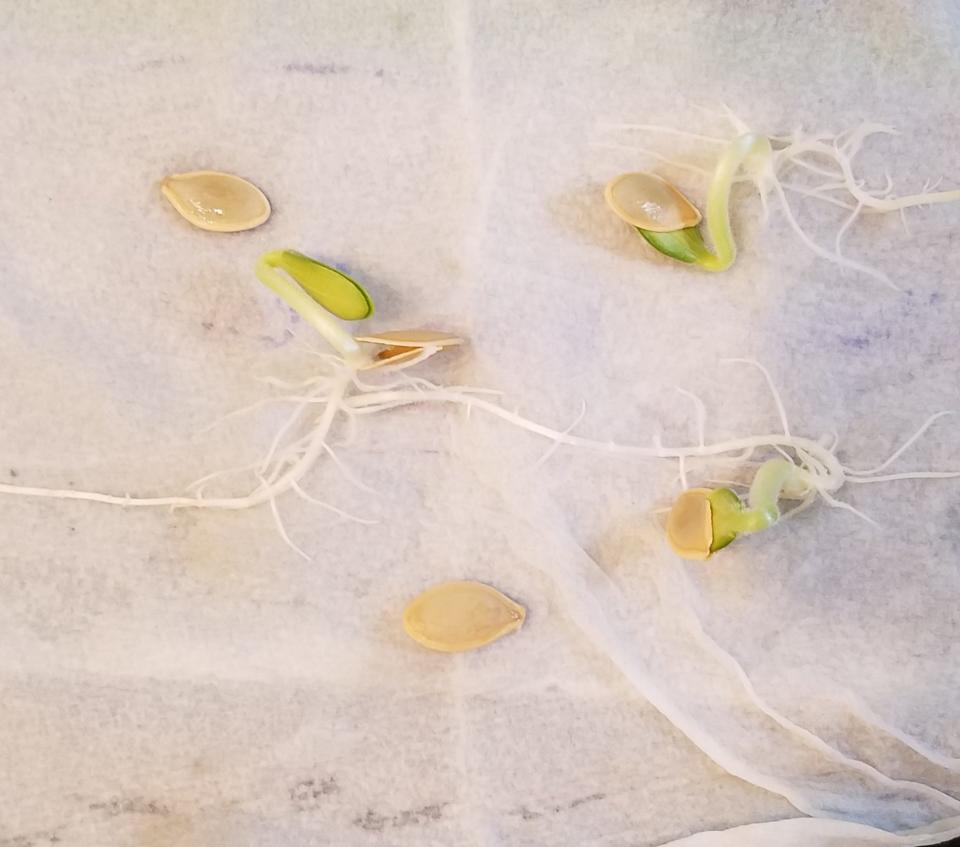Want pumpkins in time for Halloween (and pie)? Start prepping plans now | Sally Scalera
You might not be thinking of pumpkins right now, but if the idea of growing your own sounds like fun, you should start planning now.
To grow pumpkins, you will need a large, sunny area for the vines to grow in and over. Just imagine pumpkins ready to be harvested in time for Halloween or to make pumpkin pie!
Our Florida Vegetable Gardening Guide recommends planting pumpkins in mid-July. That is the shortest planting window, second only to strawberries with a month-long planting window. Our bulletin also recommends the varieties Big Max, Connecticut Field, Prizewinner, Jack Be Little, and Jack O’ Lantern, which would all be great on your doorstep or for pies.

When I visited a local garden center, Big Max, Connecticut Field, Jack O ’Lantern, Big Moon, EZ Grow Monster, and Small Sugar seed packets were available. While shopping for the pumpkin seeds, pick up a packet of sunflower (I purchased Busy Bee Sunflower seeds) or salvia seeds because they will come in handy later.
I chose the Small Sugar packet because I like little, which goes along with my love for miniature dachshunds! I will start them in a moist paper towel this weekend or next. They take about a week to germinate, so once the root and cotyledons have formed, plant them in four-inch pots filled with fast-draining potting mix. I place the pots in a tray because when the seedlings are potted up, they can handle water in the tray since the roots are above the water level. Place the tray of pumpkin seedlings outside in a sunny location that you will walk by often so you can keep an eye on them and water when needed. They can stay there for a few weeks as the seedlings grow.
More: Lettuce talk growing veggies: Tips abound for Brevard gardeners | Sally Scalera
More: Improper pruning? Unneeded topping? Consider talking to a certified arborist | Sally Scalera
the pumpkin and flower seedlings have produced at least one pair of true leaves, which will look very different from the cotyledons, they can be planted in the ground. If you don’t have a dedicated garden area, find a sunny spot near other plants and plant them there. About half an hour before you plant your seedlings in the ground, water them thoroughly in the tray with a liquid organic fertilizer (i.e., Neptune’s Harvest Fish and Seaweed Fertilizer, etc.) so the root ball of each seedling is heavy and dripping wet when they are placed in the planting hole. While the seedlings are soaking up the water and fertilizer, dig the holes and scatter some earthworm castings in each one.
When planting the seedlings, be sure not to plant them too deeply and press the soil around the root ball. After planting, water them and the surrounding soil, and then apply mulch around the plants to protect the soil. Keep an eye on your newly planted pumpkin (and flower) plants and water them when their leaves begin to wilt. After the plants are established, they won’t require as much water, but still check the plants daily and water as needed.
Let the pumpkin vines act as a ground cover as they run rampant over the mulch or possibly the (dare I say) lawn. Bees are needed for pollination, so I suggested purchasing a packet of pumpkin and flower seeds. Having nectar plants growing near the pumpkin vines will attract the bees for their pollination services. Pumpkin vines typically open the male flowers in the morning and the female flowers in the afternoon. Bumblebees pollinate and improve fruit sets for pumpkin plants, and they are hard workers who work faster than honeybees and can be out in cooler temperatures. You can also plant crimson clover, African blue basil, dotted horse mint, Monarda punctata (trim in early summer to keep it bushier), and salvias, including our native salvia species S. coccinea, Tropical red sage, S. azurea, Azure blue sage, and S. misella, Creeping sage, which is a groundcover, to attract bumblebees. Bumblebees have long tongues and can drink nectar from tubular flowers.
To produce the healthiest pumpkins possible, improve the soil health in your yard. This can be done by establishing the soil food web (around the root systems growing throughout your yard) to provide the plants with the necessary nutrients. Plants supported by the soil food web will require less help from you! For more information on germinating seeds in paper towels and/or establishing the soil food web, email the UF/IFAS Extension Brevard County Master Gardeners at brevard-mg1@ifas.ufl.edu.
Growing your own pumpkins for Halloween or pumpkin pie can be a fun and rewarding activity. Sitting outside watching the bees go from flower to flower can also be entertaining. So, why not visit the garden center today and buy some seeds to grow in your yard?
Sally Scalera is an urban horticulture agent and master gardener coordinator for the University of Florida’s Institute of Food and Agriculture Science.
This article originally appeared on Florida Today: Start now to grow your own Great Pumpkin by fall | Sally Scalera

